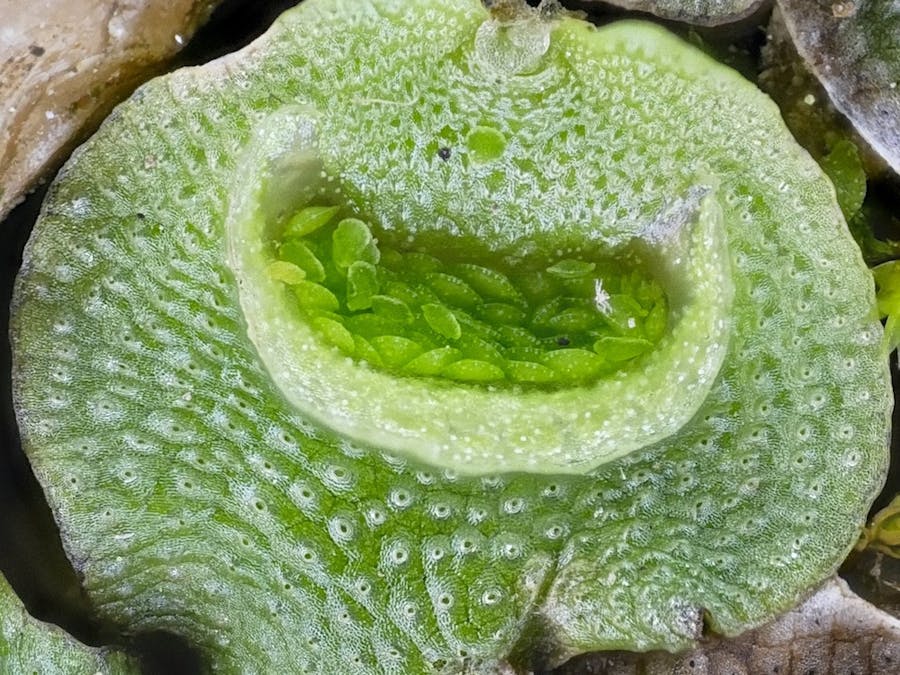The documentation of liverworts in the field, growth room or laboratory can be a challenge. The small size of the plants means that plant features may need to be captured at sub-millimetre, almost cellular scales. Recent developments in optics and electronics allow new approaches to this challenge. For example, Panasonic and Olympus digital cameras allow for bracketed focus and in-camera focus-stacking in order to capture a precise description off features in small objects. Panasonic series of cameras (e.g. G8, GX80/GX85, GH4/5) include a 4K photo mode, which allows collection of series of bracketed focus images at 4K resolution at video rates. Further, selected frames and extended focus views can be generated directly in the camera.
The Panasonic cameras, with their advanced video handling, allow the rapid collection of extended focus images. In the appropriate mode, a shutter press will result in the collection of a short video that consists of a video sweep through the observed scene. The video can be previewed and stacked in camera, but better results can be obtained by processing the movie to remove beginning and end of the clip (as the focus settles), and process the movie directly in software such as Helicon Focus.
For small plants, a macro lens is essential, and an extension tube and Raynox close-up adapter allow imaging of cell-scale features. A video ring light (or equivalent) allows work at close range. The Olympus 60mm F2.8 Micro Four Thirds lens is excellent. Alone, it has a working distance of 19 cm, which is reduced to a few centimetres with extension tube and close-up adapter - with the compensating benefit of higher magnification, high resolution and working autofocus. An example of a working system is shown below, with video and stacked image.
1. Camera, optics, lighting and support.(a) Mk I Handheld Macroscope (Spring 2017)Original setup for high resolution handheld macrophotography.
1. Panasonic Lumix GX80 camera with 16 megapixel 4/3" sensor, image stabilisation, 4K video, focus bracketing and image stacking
2. Neewer 10mm extension ring for micro four thirds camera
3. Olympus 60mm F2.8 macro lens
4. 46-43mm adapter ring
5. Raynox DVC-250 achromatic 10 diopter close-up lens
6. Kaavie video ring light with LED and under camera battery pack.
The combination of 10mm extension ring and DVC-250 with the Olympus 60mm macro lens provides magnified close-up observation, while maintaining good working distance, autofocus and image stacking. Loss of optical performance was seen with larger sized extension tubes and higher magnification close-up lens adapters.
(b) Mk II Handheld Macroscope (Summer 2017)Modified setup for more stable handheld macrophotography.
Core camera and optics setup unchanged: (see above)
6. Yeeteem 18 Macro LED Ring Light RF-600D with hi-power LEDs and diffuser ring (high light replacement for Kaavie LED system above)
7. SmallRig camera cage for GX80 (1828)
8. Top handle (1447),
9. Left side wooden handle (1891) and ARRI rosette mount (1589)
The addition of the SmallRig camera cage allows the mounting of a variety of hardware for better handling of the camera - for hand-help extended focus imaging - and for fixed mounting for laboratory work.
Comments: The camera is easier to hold and position, but would still benefit from improvements in camera support to avoid jitter during image collection, further, the angle of the LEDs in the ring light is not optimal for extreme macro work, where the subject may be ~1-2 cm from the light source.
2. Video CaptureThe Panasonic GX80 has several modes for collection of extended focus views. This can be by (i) focus bracketing using the full camera resolution and motorised adjustment of the lens focus (slow), or (ii) use of 4K video mode with automatic focus sweep and stacking using Panasonic algorithms and in-camera processing, or (iii) 4K video mode with automatic focus sweep and saving of data as an mp4 movie clip. I have mainly used the last technique, as this is relatively fast, doen't tie up the camera with processing, and produces better stacked images for hand-held shots at high magnification.
In 4K extended focus mode, the Panasonic camera will capture the depth of field of an entire scene, finding a point of focus, racking forward and then sweeping through different planes of focus across the scene. This produces a 4K video clip has a resolution of 3840 × 2160 pixels, and can be directly imported to a computer for editing. However, the beginning and end of each movie clip will contain extra images due to focus-hunting. It is helpful to remove these additional frames for high quality focus stacking of hand-held images.
Clips were loaded into a simple video editing application (Shave Video for OS X). The clips were trimmed to remove stray frames with focus hunting at the beginning and end of each image sequence. A rescaled version of the edited sequence is shown below. In this case, the trimmed movie consisted of 176 frames of 8 megapixels, was captured automatically in a few seconds (30 fps), and then was directly imported as an mp4 video into Helicon Focus for frame alignment and focus stacking.
Helicon Focus is a commercial software package that is dedicated to processing of extended focus images. It has a number of algorithms and useful facilities for focus stacking, and especially used, it allows the direct input of mp4 movies - which make file management much easier, as individual stacks can contain hundreds of images.
The link to some more real-world examples are shown below - with our favourite subject, Marchantia polymorpha. For these images, the camera was propped next to the plant, either braced against the ground, or supported on a mini-tripod. Image stabilisation was used in camera, and the focus-stacking software provides image registration for small movements between frames. see: http://haseloff.plantsci.cam.ac.uk/imaging/macrophotography/index.html
The Panasonic system was put together after testing the Olympus TG4 on a Bryophyte field trip. The TG4 is an extremely robust point-and-shoot camera that can be equipped with an LED illuminator (LG-1), see website. The camera can be used in Microscope mode, which provides a short working distance (down to 1 cm) and a simple focus stacking system with less than a dozen frames. Highly portable, fully sealed and waterproof with GPS and capable of good, web quality images. Example images can be found here. This camera has been updated, and the TG-5 should provide higher quality extended focus images in the same compact and robust package.












Comments
Please log in or sign up to comment.